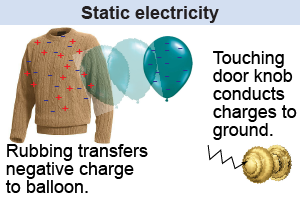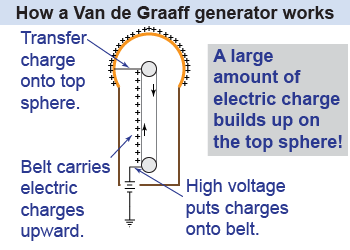|
Have you ever been zapped by a metal doorknob after walking across a carpet on a dry day? Have you ever rubbed a balloon against your sweater and watched your hair stick out? These experiences are examples of static electricity. Static electricity is a reminder that all matter contains electric charge. We don’t normally sense this because positive and negative charge are rarely separated. In extreme cases such as lightning, however, electric charge is revealed for the powerful phenomenon that it is. This section introduces the fundamental concepts of electric charges and forces. 
|
Static electricity
|
Static electricity is caused by a very tiny excess of positive or negative electric charge. Until the 18th century, however, the cause of static electricity remained unknown. In 1750, Benjamin Franklin proposed an experiment to demonstrate his hypothesis that static electricity and lightning were related. Within the next few years Franklin and others proved that “sparks” could be extracted from clouds. Lightning is nothing more than static electricity on a very large scale. The physics of lightning and charges at rest (static) is called electrostatics and is the subject of this section. Moving electric charges make electric current, which was discussed in the previous chapter. 
|
 When you rub a balloon against a wool sweater the balloon will subsequently attract your hair. Why? While rubbing, the sweater transfers some negative charges to the balloon. The balloon now has a net negative charge and the sweater has an equal net positive charge. A similar process takes place when you shuffle your feet along a rug. When you touch a metal conducting surface, such as a door knob, the built-up charge you have collected is attracted to its opposite partner through the metal conductor of the doorknob and, briefly, a tiny electric current flows. The current is what makes the zap!
When you rub a balloon against a wool sweater the balloon will subsequently attract your hair. Why? While rubbing, the sweater transfers some negative charges to the balloon. The balloon now has a net negative charge and the sweater has an equal net positive charge. A similar process takes place when you shuffle your feet along a rug. When you touch a metal conducting surface, such as a door knob, the built-up charge you have collected is attracted to its opposite partner through the metal conductor of the doorknob and, briefly, a tiny electric current flows. The current is what makes the zap! 
|
 The amount of static electricity you can create with a balloon is relatively small. To produce a larger static charge you might use a Van de Graaff generator. Inside a Van de Graaff generator, a high-voltage power supply puts electric charge onto a moving insulating belt. When the belt reaches the top, a metal contact conducts the charge out onto the surface of a conducting metal sphere. The sphere of a Van de Graaff generator can reach thousands or even millions of volts. Fortunately, the high-voltage shock from a table-top-sized Van de Graaff does not contain enough electric current to seriously hurt you.
The amount of static electricity you can create with a balloon is relatively small. To produce a larger static charge you might use a Van de Graaff generator. Inside a Van de Graaff generator, a high-voltage power supply puts electric charge onto a moving insulating belt. When the belt reaches the top, a metal contact conducts the charge out onto the surface of a conducting metal sphere. The sphere of a Van de Graaff generator can reach thousands or even millions of volts. Fortunately, the high-voltage shock from a table-top-sized Van de Graaff does not contain enough electric current to seriously hurt you. 
 |
Van de Graaff generators are often used as a static electric charge demonstration apparatus, both in classrooms and in science museums. The main scientific use has been as a power supply for atomic particle accelerators in nuclear physics experiments. Unfortunately, the maximum particle energies that a typical Van de Graaff generator can produce are no longer competitive with cutting-edge research into particle physics, so the generator has only limited ongoing use as a scientific instrument. 
|
What is the difference between electricity and static electricity?
 |
Electricity is the flow of electric charge. Static electricity is the buildup of a net electric charge. You usually realize the presence of static electricity only when it discharges, such as by giving you a shock when you touch a doorknob. 
|

